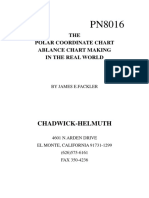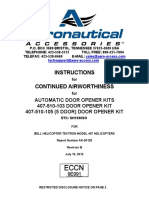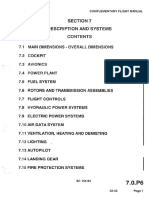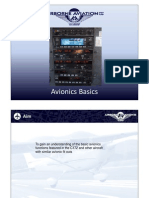Low G and Mast Bumping
Low G and Mast Bumping
Uploaded by
chakri1729Copyright:
Available Formats
Low G and Mast Bumping
Low G and Mast Bumping
Uploaded by
chakri1729Copyright
Available Formats
Share this document
Did you find this document useful?
Is this content inappropriate?
Copyright:
Available Formats
Low G and Mast Bumping
Low G and Mast Bumping
Uploaded by
chakri1729Copyright:
Available Formats
Emergency operations
XI-H. LOW G CONDITIONS AND MAST BUMPING
Ref: RFH (11-10)
1. INTRODUCTION
Probably the scariest of emergency conditions due to speed of reactions required and consequences if correct recovery procedure is not followed. Only a problem with teetering / semi rigid rotor hubs.
2. DESCRIPTION
Pushing the cyclic control forward abruptly from either straight-and-level flight or after a climb can put the helicopter into a low G (weightless) flight condition. When a push-over is performed, the angle of attack and thrust of the rotor is reduced, causing a low G or weightless flight condition. Feeling of being light in the seat. Loss of lateral control Leads to no left horizontal component of thrust Thrust from tail rotor which is above the CG now acts to the right causing a rapid roll to the right
3. CORRECTIVE ACTION
DO NOT attempt to stop the right roll by applying full left cyclic before regaining main rotor thrust, the rotor can exceed its flapping limits and cause structural failure of the rotor shaft due to mast bumping, or it may allow a blade to contact the airframe. Avoid the conditions where it might occur o Turbulence o Abrupt movement of the cyclic and collective o Push over from a climb Immediately and smoothly apply aft cyclic Do not attempt to correct the rolling action with lateral cyclic. By applying aft cyclic, you will load the rotor system, which in turn produces thrust. Once thrust is restored, left cyclic control becomes effective, and you can roll the helicopter to a level attitude.
CFI Binder Jonathan Beeby
You might also like
- Master SoCal Backcountry Airstrip GuideNo ratings yetMaster SoCal Backcountry Airstrip Guide10 pages
- AS350 B2 - CH 01 - FLT Manual - General LimitationsNo ratings yetAS350 B2 - CH 01 - FLT Manual - General Limitations36 pages
- CENTURY Troubleshooting For Old AutopilotsNo ratings yetCENTURY Troubleshooting For Old Autopilots7 pages
- ATA 24 - Cessna - Alternator Charging System 38-52-60 Amp Service - Parts Manual - D5107 - Rev 1 - 19930802100% (1)ATA 24 - Cessna - Alternator Charging System 38-52-60 Amp Service - Parts Manual - D5107 - Rev 1 - 19930802127 pages
- Sop On Aerial Spraying Including Use of Drones 1No ratings yetSop On Aerial Spraying Including Use of Drones 114 pages
- RR-Model 250 FADEC System Familiarization (Transcript)No ratings yetRR-Model 250 FADEC System Familiarization (Transcript)12 pages
- Acceptable Means Compliance Guidance Material Part 147 Module 12 Helicopter Aerodynamics Structures SystemsNo ratings yetAcceptable Means Compliance Guidance Material Part 147 Module 12 Helicopter Aerodynamics Structures Systems4 pages
- Sample of Written Examination QuestionsNo ratings yetSample of Written Examination Questions50 pages
- 72.00.00 Engine - Description and OperationNo ratings yet72.00.00 Engine - Description and Operation13 pages
- Temporary Revision: Maintenance Manual Extra 300/ScNo ratings yetTemporary Revision: Maintenance Manual Extra 300/Sc40 pages
- Rapport Technique D'Evaluation: Technical ReportNo ratings yetRapport Technique D'Evaluation: Technical Report46 pages
- EC-155B1 Complimentary Flight Manual - Section 7 Description and Systems100% (1)EC-155B1 Complimentary Flight Manual - Section 7 Description and Systems118 pages
- Multi-Function Display Pilot's Guide: Software Release 4 or LaterNo ratings yetMulti-Function Display Pilot's Guide: Software Release 4 or Later184 pages
- Before Taxi Before Engine Start: Piper Arrow N872WL PA-28R-200 (P28R)No ratings yetBefore Taxi Before Engine Start: Piper Arrow N872WL PA-28R-200 (P28R)3 pages
- Component Symbols: Pressure TransmitterNo ratings yetComponent Symbols: Pressure Transmitter21 pages
- Airman Certification Standards: Commercial Pilot - Helicopter (2025): FAA-S-ACS-16From EverandAirman Certification Standards: Commercial Pilot - Helicopter (2025): FAA-S-ACS-16No ratings yet
- Vertical Navigation (VNAV) : Flight Management Computer Systems (FMCS)100% (2)Vertical Navigation (VNAV) : Flight Management Computer Systems (FMCS)26 pages
- A Layman's Guide To Attitude Heading Reference Systems (AHRS) - Helicopter Maintenance MagazineNo ratings yetA Layman's Guide To Attitude Heading Reference Systems (AHRS) - Helicopter Maintenance Magazine4 pages


































































